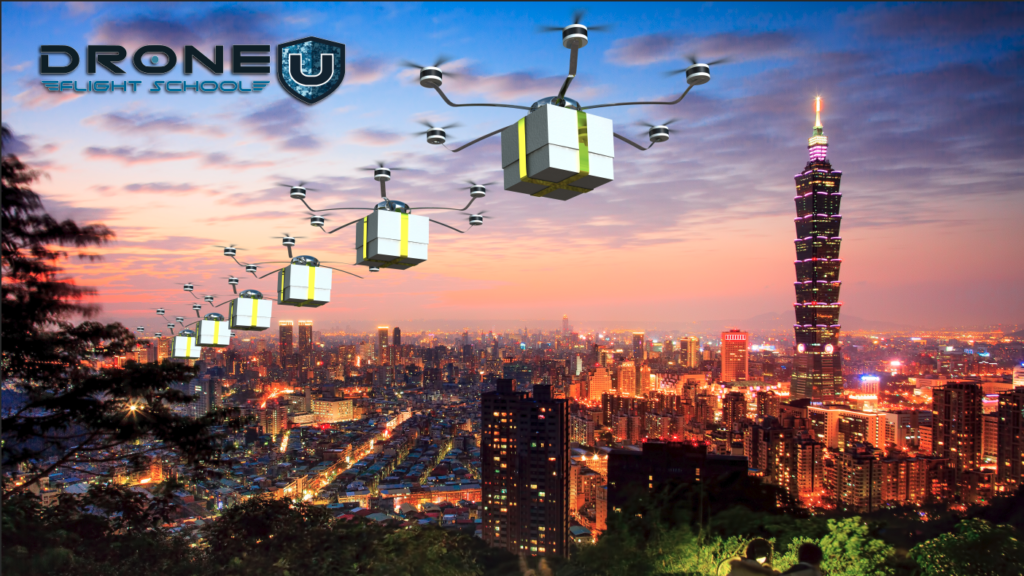Drone delivery may be possible for Part 107 unmanned pilots under specific circumstances as the FAA has clarified regulatory requirements.
Major Points:
- Drone industry insiders believed drone delivery was only possible under Part 135, not Part 107
- Part 107 Pilots can offer drone delivery
- Three Major requirements must be met to offer drone delivery without 107 waivers
- Interstate Delivery, Mail Distribution and Foreign entities are the only restrictions facing part 107 drone delivery.
- Drone delivery could aid the Fight against COVID-19 by delivering test kits and anti-body kits, but drones could not return the bio-samples as they are hazardous materials.
- Drone delivery can’t be made to the public
For years, companies like Amazon and other drone businesses thought drone delivery was impossible under part 107,
Since 2013, Amazon has been promising drone delivery to the American society, yet we haven’t seen drones flying over neighborhoods. Why is that?
In a recent article, we discussed that drone delivery might actually be possible to help stop the coronavirus. Many drone pilots reached out and stated there may be a way to delivery under 107. Begging the question, how are drone deliveries occurring on golf courses?
What did millions of dollars of lobbying money to push drone delivery actually do for the industry?
A whole lotta nothing…. Takes massive fear and change to get humans to change. So after a pandemic, it seems like questions have poured into the FAA on how drone delivery can be used to aid virus fighting efforts.
So, How is drone delivery actually possible under Part 107 and what requirements must be met?
Due to the restrictions of Part 107, many drone companies have looked to Part 135 to certify their aircraft as “air carriers.” Typically these companies are performing a service called “air commerce.” Does the definition of air carriers apply to part 107 pilots?
Putting our research hats on, we find that the definition of air commerce only applies to:

One of the key-performance-indicators holding drone businesses back has been the term “interstate,” in regards to the air commerce definition. Essentially, if your drone crosses state lines for whatever reason, you would have to be Part 135 certified, as an air carrier. This astronomically high barrier to entry for air carriers was designed for airlines like Atlas Air, who’s the backbone of Amazon Prime Air.
What if drone pilots are not delivering goods across state lines then?
Well, it seems as though many people have been asking this question. It seems if drone pilots keep to Intrastate commerce, that the air carrier provisions wouldn’t apply.
Well if drone companies need not apply for Part 135 air carriers by sticking to intrastate commerce, what’s holding them back from operating under Part 107?
Transversing people, or as we would call it, technically flying over people and BVLOS operations…..
Well as the Flying Dutchman and I discussed on the podcast it seemed quite possible to conduct drone delivery if three particular circumstances were met.
- Intrastate travel only:
- Example: delivery from say a distribution center in Las Vegas to a home in Henderson.
- Cannot Flying Over People
- Drone delivery cannot fly over people
- While some public safety agencies are willy-nilly given traversing over people waivers, it might be time to standardize this for the industry as a whole
- Flight over people waiver still doesn’t make sense when a helicopter is allowed to fly at any altitude in order to make an emergency landing according to 14 CFR 91. 119 section C.
- Drone delivery cannot fly over people
- Cannot Fly BVLOS (Beyond Visual Line of Sight… don’t pronounce it “b-vlos”…)
- Part 107 operations are limited to “visual line of sight”
- FAA has never defined technical definition of VLOS
- Part 107 operations are limited to “visual line of sight”
Last caveot we learned about operating drone delivery, is that deliveries can only take place from the company to the company. The drone deliveries cannot be “holding to the public.” Let’s take the example of the golf course. The golf course will drone delivery food from the kitchen to a snack shack or other piece of property owned by the golf course. The drone delivery cannot take place from the golf course to the players directly. Rather, the drone delivery could take place from the kitchen to the moving snack cart.
(remember i’m not a lawyer, just a loud mouth son of one…this is not legal advice)
Can you operate a drone delivery business under Part 107 without waivers?
The answer is surprisingly yes, as long as you stay visual line of sight and program flight paths that minimize the risk of flying over people. While your operations would be limited, drone pilots operating under FAA’s Part 107 regulations would be allowed to offer drone delivery. Albeit, having two simple waivers would allow for greater and expanded operations, which would arguably be more scalable.
Can you operate a drone delivery business more easily with Part 107 Waivers?
If a drone company were to acquire a BVLOS waiver and a traversing people waiver, or maybe a combination of the two, drone delivery would serve a larger group of people.
Would drone delivery actually help in the fight of Covid-19 aka Coronavirus?
One key caveat that i missed in my previous article was bio hazard delivery. Drones cannot carry any hazardous material what-so-ever. Thus drone pilots can deliver test kits and anti-body kits to patients. However, the drones would not be allowed to deliver the completed test kits back to the hospital, as they are now carrying a hazardous material.
Not sure about you as the reader, but this information has already given me a dozen business ideas……
Drone U’s director of Policy is already working on a solution for Drone U members wishing to access this potential revenue generator.
Thank you for reading the whole article,






Add Your Comment